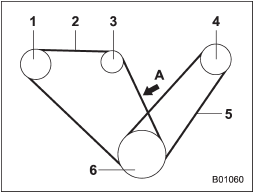Drive belts

1) Power steering oil pump pulley
2) Front side belt
3) Alternator pulley
4) Air conditioner compressor pulley
5) Rear side belt
6) Crank pulley
A) 22 lbf (98 N, 10 kgf)

The front side belt, which runs in conjunction with the following components, must be used within the specified deflection.
Х Power steering oil pump pulley
Х Alternator pulley
Х Crank pulley
Check the deflection of the front side belt and if there is any looseness, cracks, wear or unusual noise on the front side belt, contact your SUBARU dealer.
Continuing to use the vehicle with the belt outside of the specification may cause the engine to malfunction and the above components to malfunction.
To check the deflection of the front side belt, place a straightedge (ruler) across two adjacent pulleys (alternator pulley and crank pulley) and apply a force of 22 lbf (98 N, 10 kgf) midway between the pulleys by using a spring scale. The belt deflection should be the amount specified. If the front side belt is loose, cracked or worn, contact your SUBARU dealer.

The rear side belt is a stretch-type belt, therefore the deflection does not need to be checked. If there are cracks or wear confirmed on the belts and a squeaking noise is heard from them, contact your SUBARU dealer.
See also:
Delivering superior crash safety protection
Using the advanced ring-shaped reinforcements throughout the Subaru Outback
bodyshell enhances collision safety and resistance to impacts from all
directions. In addition, the newly adopted sub-fr ...
2009 Subaru Outback review
A longtime Cars.com favorite, the Subaru Outback remains a versatile,
desirable model whose greatest shortcoming is that it's no longer unique. Along
with competing wagons like the Volvo V50 and X ...
Moonroof Ц if the moonroof cannot be closed
If the moonroof cannot be closed with the
moonroof switch, you can close the moonroof
manually.
1. Remove the plug on the roof trim of the
cargo area by inserting the end of the flathead
sc ...


